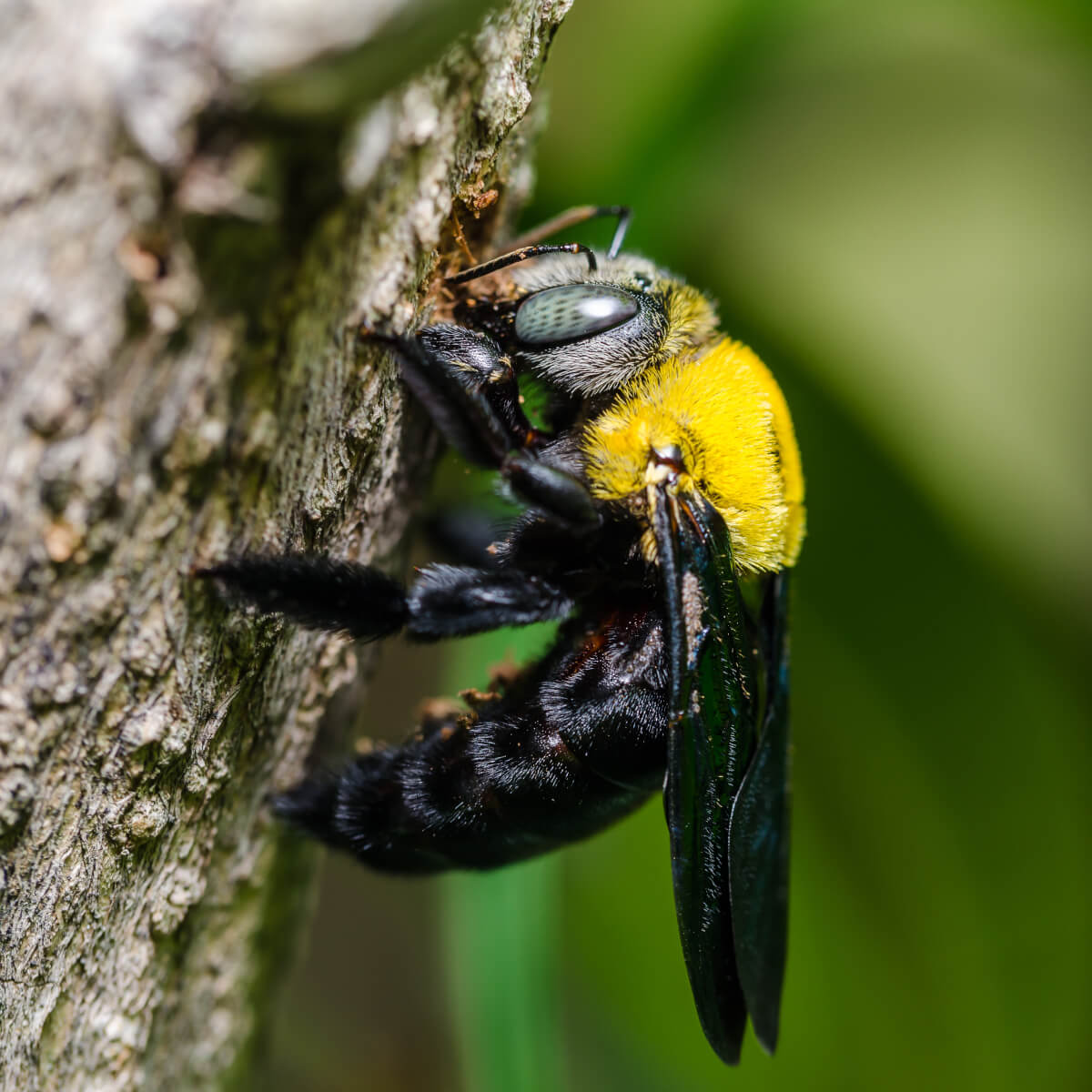Carpenter Bee
The carpenter bee (Xylocopa), or Great Carpenter Bee, is part of the Apidae family. Its name derives from the Greek word “xylokopos/ξυλοκὀπος'', which translates to “wood-cutter”. There are more than 500 species of bees in the Xylocopa genus, and they all share the name “carpenter bee” because their colouring makes it difficult to tell them apart. Carpenter bees are relatively friendly, and most of them have beautiful fur-covered bodies capable of carrying more nectar than regular honey bees.
Characteristics of the carpenter bee

- Common name: Carpenter bee
- Scientific name: Xylocopa
- Colour: Black, with yellow or white pubescence
- Lifespan: Up to 3 years
- Size: 19-26mm
- Weight: 150-250mg
- Legs: 6
- Habitat: Australia
- Nest: The carpenter bee nests in wood
- Sting risk: Low
Behaviour, habitat and life cycle
Great Carpenter Bees are native to Australia and take the crown as the most giant bees on the continent, with some of them reaching up to 26mm in length. They can be found anywhere on the continent except for Tasmania.
Generally speaking, carpenter bees are relatively docile creatures. The female carpenter bee rarely uses her sting, and the male specimen doesn’t have a sting at all. They love to burrow into hard plant material, such as dead wood or bamboo. That’s where the “carpenter” part in their name comes from.
Habitat and behaviour
Carpenter bees create their nests by excavating beautiful rounded galleries. Inside these galleries, they form nectar loaves made from a mixture of sawdust and the bee's saliva. These nectar loaves provide a perfect place for the bee to lay its giant eggs (up to 15 mm long). Once the eggs are laid, the bee forms partitions between each egg cell, using more of the sawdust/saliva mixture.
Carpenter bees are a solitary species, so their behaviour differs from social insects. Unlike honey bees and bumblebees, carpenter bees do not become queens or workers - there are only males and females. Adults spend the cold season individually, often in the same tunnels they built last year. Winter survivors emerge the following spring and mate.
As a solitary type of insect, a carpenter bee infestation sounds illogical. Nevertheless, carpenter bees can still cause damage to the wooden structure of your home, so if you suspect anything fishy - consult one of the Fantastic bee experts.
Life cycle
Female bees usually take care of the nest while male bees stand guard, but there is no established gender norm. In some cases, female carpenter bees may cohabit. Mothers and daughters either divide the labour of foraging and egg laying, or one bee does all the work while the other guards the nest.
Your pinky has about the same diameter as the holes they make in wood. When the female carpenter bee has bored in a short distance, she makes a right-angle turn and tunnels parallel to the wood surface. She makes about five or six cells inside each tunnel for holding eggs.
As the bee works backwards, it lays an egg in each cell and supplies it with pollen. Then, the cell gets sealed with digested wood pulp. The larva hatches, grows and feeds on pollen for several weeks. The younger generation of carpenter bees matures in the summer and begins their never-ending search for nectar.
Pollination
Carpenter bees don’t really have any preference for nectar sources, but they become living tuning forks when they land on blossoms. They sonicate the dry pollen grains from the anthers of flowers with their powerful thoracic muscles. The process is called “buzz pollination” and makes carpenter bees excellent at pollinating plants such as tomatoes, eggplants, potatoes and other edibles.
Carpenter bees can be incredibly clever when it comes to finding nectar. As a result of their large size, the bees can't get into long, tubular flowers like salvias, penstemons etc. Instead, carpenter bees slit open the flower’s corolla with their mouthparts, take away the nectar and leave without pollinating the plant in the process. This results in them becoming nectar robbers instead of nectar lovers.
Carpenter bees vs Bumblebees
Carpenter bees may look similar to bumble bees at first glance, but upon closer inspection, there are several key differences. Carpenter bees lack the characteristic yellow markings on their abdomens. Instead, carpenter bee abdomens are smooth and shiny, mostly black in colour. In contrast, bumblebees have hairy, black-and-yellow abdomens.
Aside from these differences, the two types of bees nest differently: the bumblebee nests in empty cavities, like abandoned rodent burrows, while the carpenter bee bores into wood.
Compared to bumblebees, carpenter bees are less likely to sting. However, they can still be intimidating, especially when mating and building nests. Male carpenter bees can be particularly menacing, hovering in front of people near their nesting sites. However, the males can't actually sting, so they're not much of a threat.